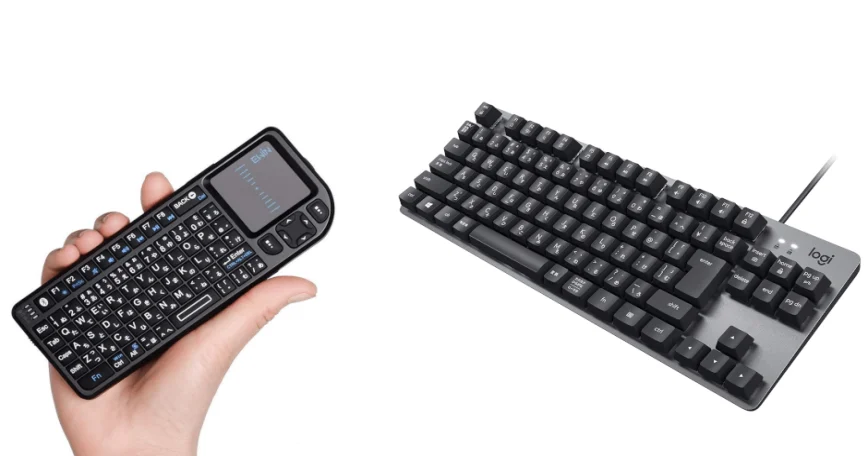Actually, it is deep. Keycap and keyboard size
When you start focusing on keyboards, you will find that the "keycap and keyboard size" is surprisingly profound. If the keyboard is too small or too large, it will be difficult to use, but if you find a keyboard that fits your body, typing will become overwhelmingly easier.
Modified at: 2023.1.24Posted at: 2022.6.29
Characteristics of keyboards with small keycaps
Narrower range of motion
As a matter of course, smaller keycaps reduce not only the overall width of the keyboard, but also the range of motion when key typing. Simply put, neighboring keys are closer together.
Mobile notebook keyboards and foldable keyboards follow this pattern.
Smaller keycap size has the advantage of reducing finger fatigue due to the narrower range of motion, but for people with larger bodies and wider shoulders, it may feel too narrow and difficult to type. In some cases, such as the "palm keyboard" in the top image of this article, too small may conversely cause fatigue.
Another disadvantage is that if you are not accustomed to a narrow key layout, you may find yourself mistyping more often.
Small keyboard size
When trying to fit the necessary keys into a small chassis, the only way to do so is to reduce the size of the keycaps or reduce the number of keys.
Reducing the number of keys too much will result in a loss of functionality as a keyboard, so it is common for small keyboards to deal with this by reducing the keycap size.
There are some negative effects of being smaller, and one of the most common cases in Japanese keyboards for notebook PCs is that the Enter key is reduced in size quite forcibly. This is surprisingly troublesome, and since the Enter key is used frequently, it is stressful to press the adjacent key frequently until you get used to it.
Characteristics of keyboards with large keycaps
Body size is wide horizontally.
The larger keycap size means that the keyboard uses that much width, so the width of the keyboard will inevitably increase.
If you are mainly writing, the larger keycap size will reduce typing errors and make it easier for you to use the keyboard. It is an image of being able to type with a sense of space.
Especially for those who type a lot of letters on a daily basis, the amount of typos directly affects the quality of their work and tasks, so it is an advantage to buy a new keyboard.
On the other hand, a full keyboard with numeric keypad, which is preferred by people who often use numbers such as accountants, is difficult to use because the mouse is positioned far to the right on a keyboard with a wide width. In terms of posture, the right shoulder will be thrust out to the right, which can cause stiff shoulders.
Keys will have more depth.
Larger keycaps mean that the keys are not only longer horizontally, but also vertically. This means that the number and function rows are farther away from the typist.
This may be a small difference for those with long fingers or those who do not use the number keys much, but for those with short fingers or small hands, having the range of motion of the fingers extended to the back is surprisingly stressful.
Is a larger or smaller keycap better?
There is no clear-cut right answer to the question, "Is larger or smaller key size better?" There is no clear-cut answer to this question.
Not only do people have different hand and finger sizes, but even people with the same body type have completely different typing sensations depending on how they use their hands, how they use their muscles, their fingering habits, and so on.
The idea is to choose a keyboard of a size that does not tire the fingers. A keyboard of a size that does not tire your fingers is one that allows you to type without moving the inside of your hand as much as possible.
To check this, place your left index finger on F and your right index finger on J, and ask yourself, "Can I reach the second row of keys from the top (row Q) without moving my hand? are the guidelines.
Some people have a habit of having difficulty in typing with their pinky or ring finger, so check if there is no difficulty or pain in the fingering by actually typing.
